The Origins and Evolution of Highfield Cricket Club

Based on records, I provide the following summary of the origins and evolution of Highfield Cricket Club.
Summary
- Pemberton Cricket Club was formed in 1857 and rented farm fields including those belonging to Sled Brook Farm near the top of Enfield Street, in Highfield.
- The Highfield Cricket Club was formed on March,16, 1877, at a meeting in the Half Way House.
- A major disaster in Blundell’s King Pit later in 1877 delayed the development of the club.
- A cricket ground was created near the bottom of Enfield Street on Blundell’s land.
- Highfield Rugby Football Club was formed about the same time and played on the Highfield Cricket Club ground: rugby in winter and cricket in summer.
- The first reports of cricket and rugby games on the ground are in 1880.
- In 1889 or 1890 Highfield Athletic Club was formed with a home on Highfield Athletic Ground, the former Highfield cricket ground. Highfield Cricket Club was one of the three sections of the Club, the other two being the Harriers and Cycling Clubs.
- The Highfield Cricket Club continued to play until about 1903. There is no designated cricket or athletic ground on the 1908 (1907) map, only a bowling green and club. Possible reasons for the decline in cricket include a bad ground, bad performances and competition from other sports.
- On May 3, 1924, Highfield Cricket Club played its first game against Platt Bridge Cricket Club on the new Highfield Recreation Ground in Billinge Road. Major Blundell donated land for the St. Matthew’s churchyard and the adjacent Recreation Ground. The churchyard was concentrated in 1923, so it is possible that the land for the recreation ground was also donated in 1923 and that Highfield Cricket Club was revitalized in 1923, with time being taken to create a cricket ground from an old farm field and to set up fixtures for the 1924 season.
Introduction
Some 150 years ago sports teams, clubs and leagues were springing up like kangaroos in the Wigan area. New sports grounds were created and some were shared.
Each district, just half a mile or a mile apart, had great local pride and competitive spirit… and Highfield was no exception. 1n 1869 the new and deep Queen and King Pits were operating and coal production was rocketing.
The lads working their backs off for Blundell’s Pemberton Colliery needed recreation and exercise between grueling shifts and the owners encouraged the establishment of teams: teamwork on the field fostered teamwork in the colliery. Colonel Blundell espoused the virtue of self-denial in training. Most of the meetings to organize the sports were held in public houses, no doubt over a few pints of beer. Inquests and annual dinners were also held in the pubs. In Highfield, the Hare and Hounds at the bottom of Tunstall Lane, the Half Way House on Ormskirk Road and the Blundell Arms in Foundry Lane were prominent.
The opening of main-line railways in the 1830s and 1840s facilitated transport (Pemberton railway station opened in 1848), although most of the travelling from ground to ground would have been on foot, on horseback, in a horse carriage, on bicycles or, later, a few trams.
In researching the origins of Highfield Cricket Club I have discovered interesting information about other Pemberton and Highfield sports clubs and their grounds. I have included some of this information, particularly as it is relevant to understanding the origins and evolution of Highfield Cricket Club.
My main source of information is Wigan Observer (WO) records in the British Newspaper Archive (https://www.britishnewspaperarchive.co.uk/).
HIGHFIELD BEFORE CRICKET WAS PLAYED
I start with the 1838 Pemberton Tithe map, which shows the field, owned by the Blundells, which c.1923/24 was donated as the site for Highfield Recreation Ground, including Highfield Cricket Club and Tennis Club. In the field to the right, Highfield St. Matthews Church was dedicated in 1894 and the churchyard was dedicated in 1923.
On the west side of the field three early colliery railway lines merge: one comes down from the Upper Venture Pit and joins a line from the Lower Venture pit, which joins a line from the Mill Pit near Pony Dick.
These horse-powered Pemberton Colliery railway lines carried coal down what would become Victoria Street to the Leeds and Liverpool Canal by Seven Stars Bridge in Wigan.
The Bury to Liverpool railway line, opened in 1848 and accessed by Pemberton Colliery, was under construction and a bridge was built to carry a road from Highfield (Colliery) over the railway line.
This road and bridge were abandoned with expansion of the colliery and the construction of Foundry Lane. Highfield House and Duck Pond Hall, to the right of the House, are shown.
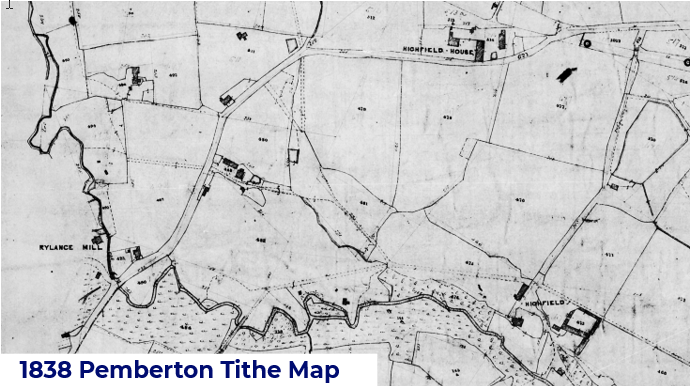
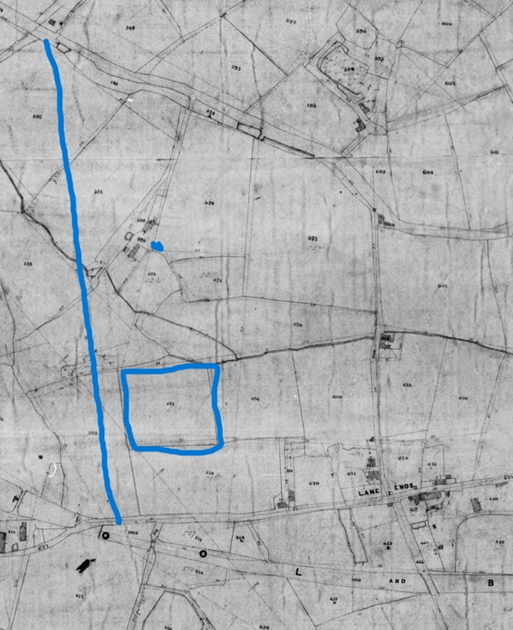
1838 Pemberton Tithe map.
I have marked on this larger section of the tithe map the future line of Enfield Street, Sled Brook Farm and the outline of what would become Highfield Cricket Ground. Highfield Rugby Football club also played on this ground, which later became the Highfield Athletic Ground, the bowling greens and Highfield Club.
The dark irregular mark across the middle of the map is Sled Brook, which started on the southeast corner of Lamberhead Green, flowed to the south of Sled Brook Farm, across Tunstall Lane, down to Thwaites Delph and discharged in Cromwell’s Ditch near Adam Bridge in Wigan. Sled Brook was known locally as Buggy Brook.
In the 1840s, Blundell’s Pemberton Colliery was ramping up coal production and a large number of bricks were needed to line the pit shafts and construct colliery buildings The 1849 Ordnance Survey (OS) map (surveyed 1845-1846), thanks to the National Library of Scotland, shows a large Brick Field between Enfield Street and Queen Street, which must have been built some years previously.
The old Hare & Hounds public house is shown on the southeast side of Lane Ends at the junction of Little Lane and Tunstall Lane. Some years later, the new Hare & Hounds was built on the northeast corner of Lane Ends. The Railway Hotel at the corner of Billinge Road and Enfield Street and the Blundell Arms in Foundry Lane had not yet been built.
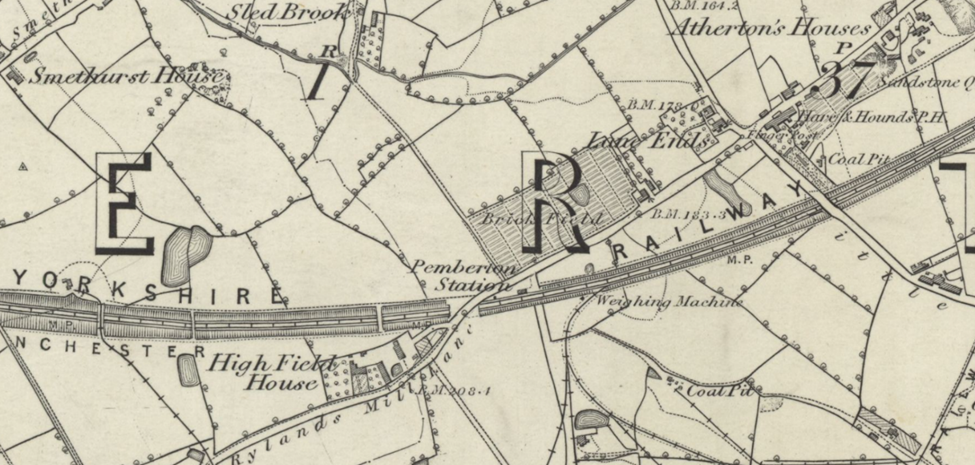
1849 OS Map
In a brick field the topsoil was typically removed and the clay beneath was stripped off and mixed with chalk and ash to make bricks.
On Saturday, October 23, 1858, Wigan Observer (WO) reports that members of Pemberton Cricket Club celebrated their first anniversary in the Hare and Hounds Inn. The club had about 60 members and had played a few games, which they had lost. There is no information on the location of the ground.
On Saturday, June 4, 1859, WO reports that Pemberton Cricket Club beat Newtown, at Newtown, in both innings [two innings were usual at the time]. Both clubs were in their second summer, so they were both formed in 1857.
On Saturday, February 11, 1860, WO reports a meeting of members of Pemberton Cricket Club in the Bird-i-th-Hand.
On Saturday February 25, 1860, WO reports a general meeting of members of Pemberton Cricket Club. After much debate it was agreed to amalgamate Pemberton with the Wigan Club. As subsequent newsclips show, the amalgamation did not take place, or did not last.
On Friday, June 16, 1864, WO reports a cricket game between Pemberton Cricket Club and School Masters of the District. The schoolmasters won. Pemberton second team beat Orrell first team.
On Saturday, July 1, 1865, WO reports that a cricket match will be played between the second eleven of the Wigan Cricket Club and the Pemberton Club, in the Mesnes.
On Friday, January 24,1868, WO advertised the Pemberton Cricket Club Annual Ball to be held at the Mechanics Institution [in Lamberhead Green].
On Friday, July 17, 1870, WO reports a cricket match between Pemberton and Golborne at Highfield.
On Saturday, March 24, 1877, WO reports that on Wednesday a general meeting of the Pemberton Cricket Club was held in the Half Way House. It was decided to accept the offer made by Mr. Faulkner, viz, one of his fields at a yearly rent of £5. Sub-committees were formed to draw up a code of rules, and to ascertain the probable cost of the materials. Mr. W.J.L.Watkin had consented to become president of the Club. The Messrs. Taylor, of Highfield, have promised to become vice-presidents. [Mr. Faulkner was a farmer in Norley Hall.]
On Friday, March 16, 1877, WO reports that a number of gentlemen met at the Half Way House on Wednesday to consider the means to establish another cricket club besides Pemberton. Mr. Robert Laverick was voted to the chair and a number of gentlemen had already promised to become members and there were funds to pay for materials etc. It was agreed that the club be formed and a 10-man committee was established to carry out preliminary arrangements. Mr. Clarkson and Mr. Clough were elected secretary and treasurer pro tem. The committee members were instructed to visit certain fields for playing fields and to visit a number of gentlemen to secure their interest and support and to report progress on Saturday afternoon.
This must have been the start of Highfield Cricket Club. However, on October 11, 1877, a disastrous explosion in the Pemberton Colliery King Pit killed 36 men, including the Manager Mr. W.J.L. Watkin, 38, and Underlooker Mr. R. Laverick, 39. [The “L” in Mr. Watkin’s initials was for “Laverick”, so I assume that Mr. Watkin and Mr. Laverick were related. William John Greener, 23 year old son of William Greener, the first manager of Pemberton Colliery, became the next manager of the Colliery and was very involved in the local community (Cooke, 1993)].
The loss of so many men, including senior managers, and the disruption to operations were probably reasons why the first mention of Highfield Cricket Club is three years later in 1880.
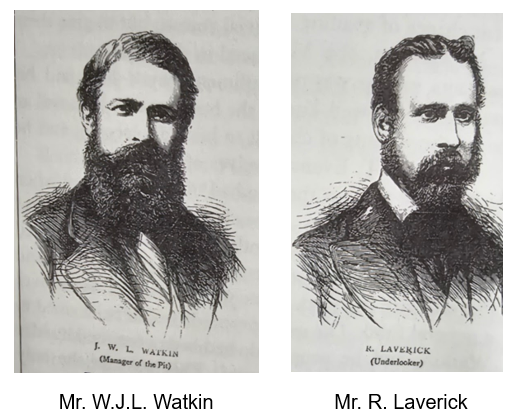
From Gordon Cooke’s book, “A History of St. Matthew’s Highfield 1867-1993,
On Saturday, June 16, 1877, WO reports a general meeting of members of Pemberton Cricket Club in the Half Way House. Colonel Blundell is a Patron.
On Saturday, August 25, 1877, WO reports that a notice is given of a grand match to be played between Pemberton Cricket Club and Twenty Two of the District on the ground of the Pemberton Club, Norley Hall Farm.
On Friday, April 25, 1879, WO reports that, due to disagreements between certain Pemberton Cricket Club officers, the commencement of the season has been delayed. At one time it was feared that the club would be allowed to fall to pieces, but the season will open on Saturday.
Highfield Cricket Club
The first mention of Highfield Cricket Club that I have found is in 1880.
On Friday, July 9, 1880, WO includes a Letter to the Editor complaining bitterly that Highfield Cricket Club decided not to amalgamate with Pemberton Cricket Club. It was noted that the Pemberton field is “very objectionable”. This proves that Pemberton and Highfield had separate cricket clubs and grounds.
In 1880, Wigan Wasps Football Club (the forerunner of Wigan Rugby Football Club) played Highfield rugby team on Highfield cricket ground near the bottom of Enfield Street (Ancient and Loyal ( https://www.ancientandloyal.com/:1879-80 Wasps). By this time the brick field had been cleared.
On Wednesday, December 22, 1880, WO reports that members of Pemberton Cricket Club held their annual dinner at the Prince of Wales Inn in Newtown.
On Friday, December 24, 1880, WO reports that “A concert was given in aid of the funds of Highfield Cricket Club was held in the Boys School, Highfield, on Monday night last, ..”.
That Highfield Cricket and Football Clubs played on this same ground is confirmed by the following:
1881, July. The Sunday Scholars Annual Treat “was held in the field of the Highfield Cricket and Football Clubs” (A History of St. Matthew’s Highfield, Gordon Cooke (1993), and a report in the WO on July 9). Flat and hurdle races were held, including an obstacle race on a course about 300 yards long.
The fact that this was described as an annual treat in 1881 and a cricket ground existed in 1880 suggests that Highfield Cricket Ground and Club were in existence in 1880. Highfield Rugby Football Club (later Wigan Highfield) must also have been formed in 1880, or earlier.
On Wednesday, February 23, 1881, WO reproduces a letter from the Honorable Secretary of Pemberton Cricket Club, Jas Clarkson, denying rumours that the club was no longer in existence. A new ground was being formed and would be ready for next season.
On Saturday, May 28, 1881, WO reports that Highfield (153) beat Earlestown (38) at Highfield.
On Saturday, June 11, 1881, WO reports that Highfield Cricket Club first team (30) beat Upholland (29) at home and Highfield second team (31) lost to Upholland (153) away. Pemberton beat Newsham (Liverpool) at Pemberton.
On Friday, July 15, 1881, WO reports that Highfield beat Howe Bridge (Atherton) at bowls on Highfield Subscription Green. The 1894 OS map (surveyed 1888-1892) shows the cricket ground and bowling green, so perhaps the cricket and football clubs, sharing the same ground, and the bowling green were all established at the same time c.1880.
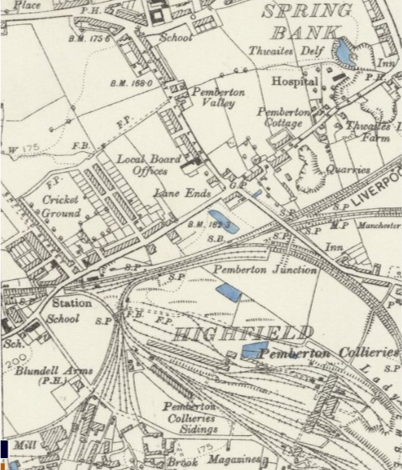
1894 OS map, surveyed in 1888-1892.
The following extracts from the fascinating website “Ancient and Loyal” on the history of Wigan Rugby Football Club contains additional interesting information relating to the origins of sports in Highfield:-
(Ancient & Loyal (ancientandloyal.com)).

Here we see that men from the Hare and Hounds running club, harriers, were founding members of Wigan Wasps Football Club in 1879 and that this running club had been disbanded shortly before. Highfield Harriers, therefore, must have been founded some time before 1879. One of Wigan Rugby Football Club’s star players, Jim Slevin, was a member and captain of the Hare and Hounds.
On Saturday, April 8, 1882, WO notes that both Pemberton and Highfield Cricket Clubs have scheduled games. On Saturday, July 8, 1882, WO reports that the annual meeting of the Pemberton Wanderers Football Club took place in the Half Way House on Wednesday. The club had won 13 of its 14 games last season.
On Friday, July 18, 1882, WO reports that Highfield bowls team beat Atherton Howe Bridge Village Club at Highfield. After the game, the “company adjourned to the “Hare and Hounds” where a grand repost was provided by Mrs. Fogg [the hostess] in capital style”.
On Saturday, September 8, 1883, WO reports that a plan for a proposed reading room, etc., to be built on land near Pemberton Railway Station, adjoining the Highfield subscription bowling green, was passed.
On Saturday, November 10, 1883, WO reports that Pemberton Wanderers beat Wigan Parish Church at football at Pemberton. Highfield could only muster 9 men for their game against Widnes Wasps and the game was called off. The Highfield second team beat Pagefield at Pemberton.
On Friday, January 21, 1884, WO reports that Pemberton Wanderers and Highfield Football Clubs will merge and the club will be known as Pemberton and the home matches will be played on the Highfield ground. [see August 21, 1886 below.]
On Friday, August 8, !884, WO reports that Platt Bridge beat Highfield at bowls on the Highfield Ground.
On Saturday, September 6, 1884, WO reports that Mr. W.J. Greener [Manager of Blundell’s Pemberton Colliery] presented the Bowling Club members challenge cup to the winner John Close. The contest had previously been played in 1882 and 1883.
On Friday, November 21, 1884, WO reports of a case in Wigan County Court in which James Clarkson of Newtown was sued by James Alker, farmer, of Pemberton to recover £3 balance of rent due for a field formally used by Pemberton Cricket Club, of which he was secretary. The judge ordered that the money ought to be paid. [Note: James Alker was a farmer at Sled Brook Farm, off the east side of Enfield Street. He farmed land from Enfield Street across to the top of Tunstall Lane, near the present-day Sled Brook Street.
It seems likely that Pemberton and Highfield Cricket Clubs had separate grounds off Enfield Street, Highfield’s ground being better than Pemberton’s, which was nearer to Sled Brook Farm.]
On Friday, June 8, 1886, Highfield (19) lost to Tonge (Bolton) (97) at bowls.
On Saturday, August 21, 1886, WO shows the 1886-87 fixture list for Pemberton Football Club, including two games with Highfield first and second teams. On September 3, 1886, WO reports that in 1879 the struggling Upholland football club merged with the Sledbrook Club which played in Enfield Street. The Pemberton Football Club have taken the ground for the following season. [So it appears that Pemberton Football and Cricket clubs played on Sled Brook Farm land to the north of Highfield Cricket Ground.]
On Friday, December 24, 1886, WO reports that Upholland Cricket Club was wound up and many of the players went over to Highfield Cricket Club.
On Saturday, April 9, 1887, WO reports that “THE HIGHFIELD BOWLING GREEN will be OPENED on Monday next, April 11, 1887.”
On Saturday, September 3, 1887, WO reports that “Highfield suffered a most severe defeat on Saturday at the hands of Westhoughton.” Highfield 32, Westhoughton 136.
On Friday, May 25, 1888, WO reports that Haigh and Highfield second teams drew a game at Highfield. It was also reported that “I am sure my Highfield friends will do their utmost to get in order their cricket pitch, which has been sadly cut up by ye wicket football players”.
On Saturday, June 14, 1890, WO reports that Highfield (54) lost to Golborne (86) at Pemberton.
On Friday, September 26, 1890, The Leigh Chronicle and Weekly District Advertiser reports that Prescott played a game against Highfield.
On Saturday, September 6, 1890, WO reports on the first match of the Pemberton Association Football Club. 1890, Friday, November 7. WOE states that last Saturday there was an inter-club run with Highfield Harriers starting at the Blundell’s Arms, Pemberton. [So Highfield Harriers must have been reformed after breaking up about 1878.]
On Saturday, August 20, 1892, WO reports that Highfield (32) lost to Dalton (82) at Highfield at cricket. On Saturday, 26 March, 1892 WO mentions Highfield Athletic Club.
Highfield Cricket Club was still in existence, but apparently struggling in 1892 as WO reports on Saturday, August 20, that the Highfield Club (32) lost to Dalton (82) on the Highfield ground, but notes that it “…appears that there is life in the old dog yet.”
On Friday, April 21,1892, WO reports that “Saturday last witnessed the annual race between the cyclist and harrier sections of the Highfield Athletic Club”. As it is reported as an annual event, the Athletic Club must have been formed prior to 1892. An 1894 article in WOE refers to the amalgamation of Highfield Cricket Club, the Highfield Harriers and the Highfield Cycling Club. [So Highfield Cricket Club was not disbanded, but operated as one of three sections of the Highfield Athletic Club.]
On Friday, April 21, 1893, WO reports the results of a 7.5 mile race between the cyclist and harrier sections of the Highfield Athletic Club. Two cyclists won, one with pneumatic tyres and one with cushion tyres. A substantial fund was made towards the track fund.
On Friday, May 12, 1893, WO reports that Highfield Cricket Club was cut up badly by Wigan Parish Church.
On Wednesday, July 19, 1893, WO reports that employees of May Mill Spinning Co. lost to the employees of Blundell’s foundry in a friendly game of bowls at Blundell Arms.
On Wednesday, April 25, 1894, WO reports that Norley Hall (61) beat Highfield (47) at Norley and the second team game at Highfield was also won by Norley.
On Saturday, July 28, 1894, WO reports that Hindley Green (109) beat Highfield (28) away. Highfield second team (63) beat Hindley Green (45) at Highfield.
On Saturday 25th August, 1894, WO reports that a wide circular cinder track had been laid on the Highfield Athletic Ground, formerly known as the Highfield Cricket Ground. At the event, John Tabener with Highfield Cricket Club won a prize for throwing a cricket ball the furthest. Colonel Blundell presented some of the prizes and espoused the virtue of self-denial in training. WO mentions Highfield Harriers in 1891-1895, the Highfield Cycling Club in 1893 and Highfield Bowls Club in 1895.
The 1893 (1892) OS map shows a football ground to the north of Orrell Road. It is also shown on the 1908 (1907) map [This was the ground for Pemberton rugby football club; see February 9, 1909.]
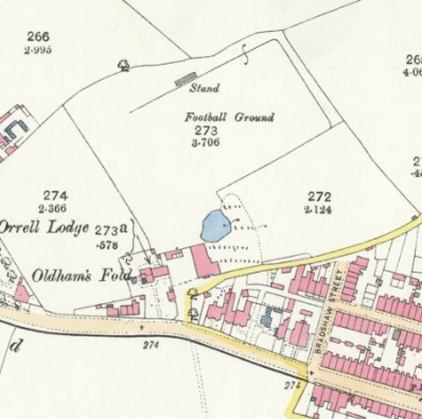
1893 OS map
Wigan Highfield Rugby Football Club went out of existence for a few years following the rugby schism of 1895. They reformed in 1902 and played in a league comprising the “A” teams of the major clubs (Wikipedia: Liverpool Stanley). It was probably when they reformed in 1902 that they opened a new ground off Tunstall Lane. This would have left the cricket ground off Enfield Street for cricket and athletics.
On Saturday, May 11, 1895, WO states that the second Amateur Athletic Sports Club will be held at Highfield Athletic Ground opposite Pemberton station on Saturday May 25, 1895, welcomes entries for a meeting. On Friday, May 24, 1895, WO cricket reports refer to “The Highfield enclosure, that neat little enclosure, close to Pemberton station, …”
On Monday, May 27, WO states that the Highfield Athletic Club committee “are to be congratulated on the financial success of their first venture. The club has sprung out of a small organization, formed some five or six years ago, called the Highfield Harriers, .…” [So Highfield Athletic Club must have been formed in 1889 or 1890 and in 1895 had a multi-purpose Highfield Athletic Ground near the bottom of Enfield Street.]
The formation of the Athletic Club in 1889 or 1890 is confirmed on the 1894 map, which shows a cricket ground near the bottom of Enfield Street together with a bowling green and a club room. As the surveying for the map took place in 1888-1892, the club must have formed in this time span.
On Wednesday, May 22, 1895, WO reports that Highfield tied with Sutton.
On Saturday June 22, 1896, WO reports that Highfield was under consideration to be included in a Senior League.
On Monday, May 25, 1896, WO states that the third annual athletic festival was held at Highfield. On Friday, October 11, 1895, WO reports that a plan to create a recreation site at Sled Brook Farm was approved.
On Thursday, August 8, 1895, The Ormskirk Advertiser shows Highfield Cricket 1st team to play Dalton at Dalton on Saturday and the 2nd teams to play at Highfield.
Highfield Cricket Club was still in business through 1903.
On Thursday, April 18, 1898. The Ormskirk Advertiser reports an engagement of “..rburgh v Highfield.” [This could be Newburgh.]
On Wednesday, June 7, 1899, WO reports that in a second team match Hindley Green (48) beat Highfield (23).
On Friday, June 30, 1899, a WO article reports that on Saturday Bamfurlong easily beat Highfield who were got rid of for 36.
On Friday, August 18, 1899, WO reports that Highfield drew with St. Mark’s in Newtown. On Saturday, August 26, 1899, a WO article reports that on the previous Saturday Highfield beat Platt Bridge at the Highfield Ground. Highfield 22 all out and Platt Bridge all out for 19.
On Saturday, October 21, 1899, WO reports a concert to support St. Cuthbert’s Cricket Club. [The recreation ground approved at Sled Brook Farm in 1895 must have been for St. Cuthbert’s, at the top of Tunstall Lane. A school had been built in 1873 and a church in 1887.]
On Saturday, July 25, 1903, WO states that “Highfield collapsed before the attack of Abram Colliery. Not a single player got into double figures, and all were out for 24.”
In 1904 the former Pemberton Urban District Council, including Highfield, merged with Wigan Municipal Borough to form the County Borough of Wigan.
Revisions to the OS map in 1907 show a bowling green near the bottom of Enfield Street, but the adjacent field is not called a cricket or athletics ground. Wigan Highfield football ground is shown near the bottom of Tunstall Lane and a cricket ground to the top end of Tunstall Lane. As evident in the following two WO reports, this was the ground of St. Cuthbert’s Cricket Club.
On Friday, August 14, 1903, WO reports on a cricket game between Hope Congregational and Pemberton St. Cuthbert’s.
On 1909, Saturday, June 19, 1909, WO reports on the Pemberton Rose Queen Festival. The procession returned to “the cricket field, off Tunstall Lane, very kindly lent by the committee of St. Cuthbert’s Cricket Club.”
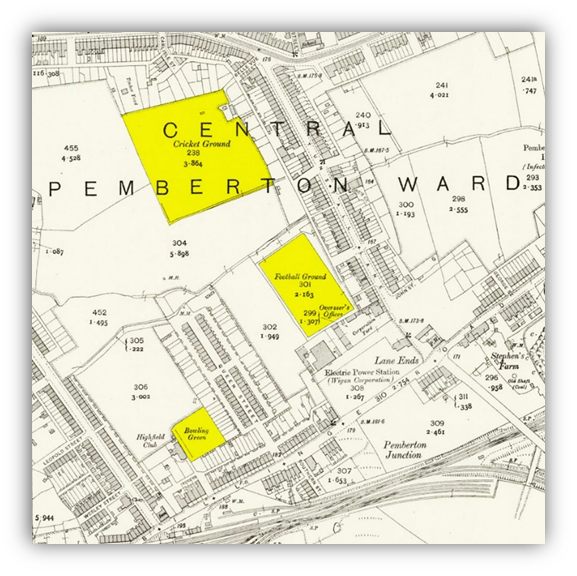
1908 OS map (revised 1907)
On Saturday, August 20, 1904, WO reports that the Pemberton Rugby Football Club has been revived and will play on the old ground. The first game will be against Highfield on September 10 under the auspices of the Wigan and District League. It is noted that attempts to bring the Association game before the district have failed.
On Saturday, July 27, 1907, WO showed a Pemberton team in the Bolton and Wigan Wednesday Cricket League.
On Thursday, August 22, 1907,WO reports that a representative from Pemberton and one from Wigan Highfield attended a meeting of the Northern Rugby League in Huddersfield.
On Saturday, October 26, 1907, WO reports that Pemberton are to play Wigan “A” at Central Park.
On Tuesday, February 9, 1909, WODA reports a football game in the Lancashire between Highfield and Warrington “A” at the Tunstall Lane Ground. Pemberton beat Runcorn A at Orrell Road. Pemberton Colliery, Pemberton Hornets and Orrell are in the Wigan and District Rugby League. Pemberton St. Cuthberts, Orrell, St. Marks, Newtown Goose Green are in the Wigan and District Combination League (Association Football).
On Saturday, June 11, 1910, WO reports on a cricket game between Pemberton A and Crawford Village at Crawford. On Saturday, July 6, 1912, WO shows the table for Wigan and District Cricket League. Highfield was not in the league. The teams were Norley Hall, Hindley Green, Standish, Chorley, Winstanley Park, Hindley, Newtown and Platt Bridge P.M. 1913, Tuesday, August 26, WO reports that a cricket game between Bethel and Plank Lane was played at Highfield. [This could be the St. Cuthbert’s ground.]
On Saturday, September 13, 1913, WO reports that Pemberton Wednesday Cricket Club have won the Bolton Wednesday League.
On Saturday, October 8, 1913, WO shows both Pemberton Rovers and Highfield in the Wigan District Rugby League In 1913, on Tuesday, October 28, a WDOE table shows a table of teams in the Wigan and District Sunday School League (Association Football), Southern Division. Highfield is bottom.
On Thursday, July 16, 1914, WO reports that Highfield Football Club are exempt in taking part in the draw for the first qualifying round of the Northern Rugby Union Challenge Cup. Pemberton Rovers drew Anchor Cable Works.
On September 2, 1923, Highfield Rugby Football Club’s new and enlarged ground off Tunstall Lane was opened.
1924, May 3. Highfield Cricket Club played its first game on the newly developed Billinge Road ground against Platt Bridge Cricket Club (Gary Speakman, “Highfield Cricket Club 1924-1999: 75 Glorious Years.”). Major Blundell donated land for the St. Matthew’s churchyard and the adjacent recreation ground. As the churchyard was concentrated in 1923, it is possible that the land for the recreation ground was also donated in 1923 and Highfield Cricket Club was revitalized in 1923.
1924, Monday, July 21. Major Blundell opened the recreation ground (cricket and tennis) and new cricket pavilion. A group of ex-Highfield Club cricketers were present “Highfield Cricket Club, 1924-1999; 75 Glorious Years”, (photo, p.9), Gary Speakman. Most of these cricketers appear to be in their 50s or 60s, so this would be consistent with them playing some 20 or 30 years ago.

1929 OS map.
This 1929 OS map shows the new Highfield Cricket Ground on Billinge Road. A second bowling green is shown at Highfield Club near the bottom of Enfield Street. The expanded ground for Wigan Highfield Rugby Football Club off Tunstall Lane is also shown. There is no cricket ground at the top of Tunstall Lane.
In 2024 Highfield Cricket Club is celebrating 100 glorious years of playing cricket on its much-admired Billinge Road ground, and 147 years since the club was formed.

Derek Winstanley, Champaign, Illinois, USA. July, 2024
Further Reading
Read "75 Glorious Years 1924-1999" by Gary Speakman, a splendid booklet celebrating the 75th anniversary history of the club produced in 1999.